Houseplants, especially flowering varieties like geraniums, begonias, African violets, and hibiscus, are a joy to grow indoors. Their vibrant colors and delicate blossoms can brighten any room and bring a sense of nature into your home. But many indoor gardeners struggle to maintain healthy, blooming flowers throughout the year—particularly after winter dormancy or periods of low light.
If you want your flowering houseplants to start blooming early and continue to do so well into the year, there’s a simple solution you can apply in April. This natural plant boost strengthens roots, revives foliage, and triggers the formation of buds. When used properly, it helps ensure beautiful and long-lasting blooms, not just in spring, but year-round.
Why April Is the Best Time to Start
April is a turning point for indoor plants. As daylight hours increase and temperatures rise, houseplants shift out of their dormant phase and prepare for active growth. This is the ideal time to support them with a gentle, effective feed that promotes flowering and strengthens plant immunity after the colder months.
Early spring feeding can help:
-
Stimulate strong root development
-
Encourage the first wave of flower buds
-
Prevent yellowing, weak stems, and leaf drop
-
Enhance the plant’s resilience to pests and stress
Giving your plants a head start in April sets the foundation for continuous blooming into summer and beyond.
The Natural Bloom-Boosting Mix
This simple and effective feeding solution uses a few common ingredients to deliver nutrients and beneficial compounds directly to the root zone.
You’ll need:
-
1 liter of room-temperature water (preferably non-chlorinated)
-
1 teaspoon of hydrogen peroxide (3%)
-
1 teaspoon of Epsom salt (magnesium sulfate)
-
A few drops of iodine (optional, for disease prevention)
This mix is easy to prepare and works for a variety of flowering houseplants, including geraniums, petunias, and indoor roses.
Why These Ingredients Work
-
Hydrogen Peroxide helps oxygenate the soil, improving root respiration and discouraging harmful bacteria or fungi. It’s especially useful for plants coming out of winter dormancy.
-
Epsom Salt supplies magnesium and sulfur—two key nutrients involved in chlorophyll production and flower formation. Magnesium is essential for energy transfer in plants and helps improve the intensity and duration of blooming.
-
Iodine (optional) can help boost a plant’s natural defenses, reducing the risk of fungal issues like root rot or powdery mildew.
This natural feeding approach offers gentle but noticeable results, helping plants recover faster from dormancy and prepare for vigorous blooming.
How to Prepare and Apply the Solution
-
Mix Ingredients: In a 1-liter container of water, dissolve 1 teaspoon of Epsom salt. Add 1 teaspoon of hydrogen peroxide. If using iodine, add 2–3 drops. Stir well.
-
Water at the Base: Use this mixture to water your plants at the base, near the roots. Avoid splashing the leaves, especially if your plants are in direct sunlight, to prevent burning.
-
Apply Once Every 2 Weeks: Begin in early April and repeat the process every 10–14 days. This routine can be continued through spring and summer.
-
Observe and Adjust: You should begin to see stronger, greener foliage and the first signs of budding within a couple of weeks. If your plant is blooming heavily, you can space out the feedings to once every 3 weeks.
Additional Tips for Continuous Blooming
While the April tonic sets your plants up for success, long-term results also depend on good plant care practices:
-
Light Matters: Place flowering plants in the brightest spot available. South or east-facing windows are ideal for geraniums and most bloomers.
-
Regular Deadheading: Removing spent blooms encourages the plant to produce more flowers instead of focusing energy on seed formation.
-
Proper Watering: Avoid extremes. Keep the soil evenly moist but not soggy. Let the top inch dry out between waterings.
-
Repot If Needed: If your plant hasn’t been repotted in over a year, consider refreshing the soil or moving it to a slightly larger pot.
-
Rotate Plants: Turn pots every couple of weeks to promote even growth and prevent lopsided plants.
Results You Can Expect
After the first few applications, your geraniums and other flowering houseplants will begin to show:
-
Lush, green foliage
-
Stronger, more upright stems
-
A noticeable increase in flower buds
-
Longer-lasting and more vibrant blossoms
With continued care and this simple feeding strategy, many plants will bloom not only in spring and summer but can even maintain sporadic flowering throughout autumn and winter indoors.
Conclusion
Giving your geraniums and other houseplants this gentle boost in April can make a world of difference. By preparing them early with nutrients and oxygen-rich support, you help them transition into their growth season with strength and vitality. The result? Months of healthy growth, stunning blooms, and a more beautiful indoor garden space.
This simple yet powerful method is perfect for home gardeners looking to maximize flower production naturally. Try it once, and your plants will thank you with blooms that last long and return reliably year after year.


